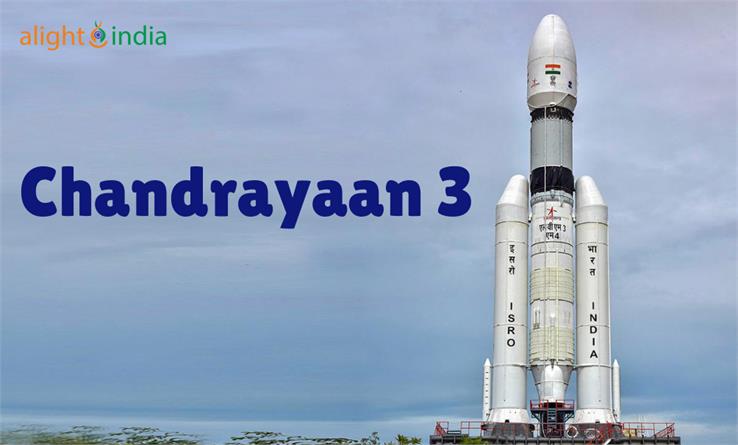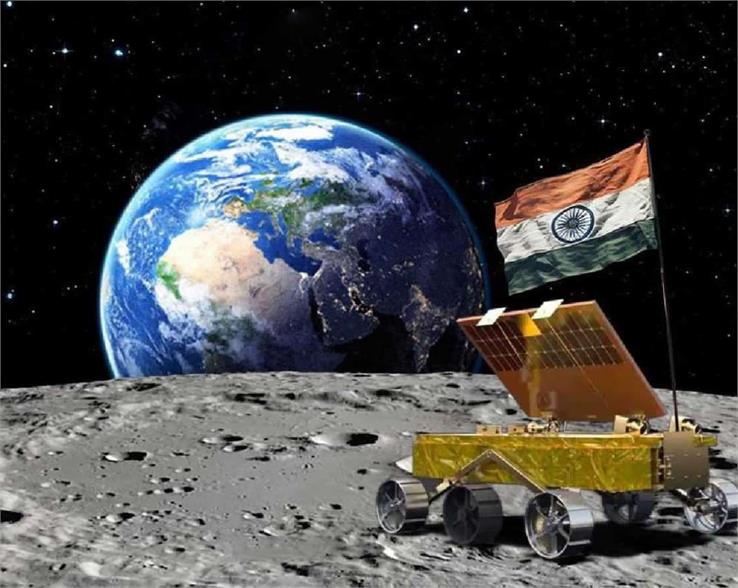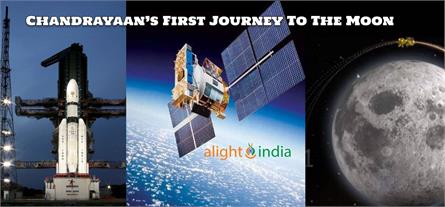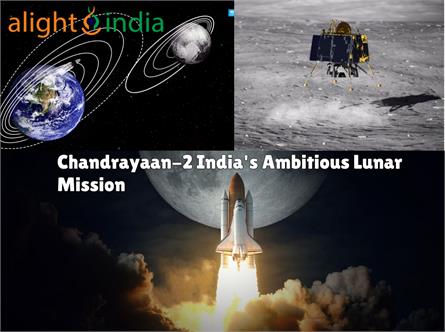The Remarkable Journey of Chandrayaan-3 | India's First Landing on Moon's South Pole

India continues to make significant strides with its ambitious space programs in the ever-expanding space exploration arena. One endeavor that has captured the world's attention is the Chandrayaan-3 mission, the third installment in the Indian Space Research Organisation's (ISRO) lunar exploration saga. Launched on July 14, 2023, Chandrayaan-3 marks a decisive leap towards achieving scientific breakthroughs and enhancing India's space prowess.
Also Read: Chandrayaan-1, a historic lunar mission that unveiled Mysteries of the Moon
Aiming for the Moon | Significance | India's Ambition
Chandrayaan- Three's primary objective is to showcase India's prowess in orchestrating a safe lunar landing and rover operation. Following its predecessor, Chandrayaan-2, this mission aims to achieve a soft landing on the Moon's surface, showcasing ISRO's technological advancements in precision landing capabilities. The mission demonstrates ISRO's dedication to pushing boundaries and setting new standards in lunar exploration. The mission carries a lander named Vikram and a rover named Pragyan, similar to those deployed during Chandrayaan-2. The lander-rover duo is accompanied by a propulsion module, which propels them to a 100-kilometer lunar orbit. This multi-component configuration highlights ISRO's commitment to holistic and integrated mission planning.
Also Read: History and Culture of India
Goals and Objectives
Chandrayaan-3, the upcoming lunar mission, has a primary focus on achieving a successful soft landing on the Moon's surface. This objective is particularly important after the setback faced by Chandrayaan-2's lander. The mission's primary objectives include:
1. Soft Landing
Chandrayaan-3 intends to achieve what its predecessor could not – a successful soft landing of a lander and rover on the lunar surface. This milestone is crucial for ISRO's ambitions in developing lunar exploration technology and enhancing its capabilities.
2. Scientific Exploration
The mission aims to continue the scientific exploration of the Moon, studying its geology, mineral composition, and surface features. By conducting on-site experiments, the rover will gather data that can contribute to our understanding of the Moon's evolution and history.
3. Technological Advancement
Chandrayaan-3 is an opportunity for ISRO to develop further and test advanced landing technologies, autonomous navigation systems, and rover capabilities. The mission's success could pave the way for more complex missions to other celestial bodies in the future.
Also Read: Chandrayaan- 2 a remarkable demonstration of India's growing capabilities in space exploration
A Historic Launch and Lunar Orbit
Chandrayaan-3 embarked on its journey aboard an LVM3-M4 rocket from the SDSC (Satish Dhawan Space Centre) in Sriharikota, Andhra Pradesh. After entering an Earth parking orbit, the spacecraft executed a series of maneuvers to place itself in a trans-lunar injection orbit. On August 5, a significant milestone was achieved when the spacecraft successfully entered lunar orbit, thanks to the meticulous efforts of ISRO's Telemetry, Tracking, and Command Network (ISTRAC) in Bengaluru.
Components and Innovations
Certainly, let's delve into the details of each component of the Chandrayaan-3 mission: the Propulsion Module, the Lander, and the Rover.
1. Propulsion Module
The Propulsion Module plays a pivotal role in Chandrayaan-Three's mission, responsible for transporting the Lander and Rover to lunar orbit. Here are its key features:
a. Spectro-polarimetry of Habitable Planet Earth (SHAPE) Payload: One of the most innovative aspects of the Propulsion Module is the inclusion of the SHAPE payload. This payload is equipped with advanced sensors and instruments designed to capture crucial spectral and polarimetric data of Earth from the lunar orbit. This data contributes significantly to our understanding of Earth's atmosphere, climate, and other critical aspects, providing valuable insights for Earth science.
b. Transportation: The Propulsion Module's primary function is to propel the Lander and Rover from Earth to the Moon. It ensures a precise trajectory and orbits insertion, enabling the subsequent phases of the mission.
c. Precision Control: The module incorporates advanced guidance and control systems to ensure precise maneuvers throughout the mission. This is crucial for achieving the desired lunar orbit and facilitating a successful soft landing.
2. Lander (Vikram)
The Lander is engineered for a soft landing on the lunar surface and is equipped with several innovative features:
a. Enhanced Impact Legs: To ensure a stable and secure landing, the Lander is equipped with enhanced impact legs. These legs are designed to absorb and dissipate the kinetic energy generated during descent, minimizing the risk of damage upon landing.
b. Laser Doppler Velocimeter (LDV): The Lander is equipped with an LDV, a sophisticated instrument that precisely measures its velocity during descent. This technology is vital for ensuring a controlled and safe landing on the lunar surface.
c. Scientific Instruments: In addition to its landing equipment, the Lander carries a suite of scientific instruments designed for lunar surface analysis. These instruments enable the collection of data related to lunar geology, mineral composition, and other surface characteristics.
3. Rover (Pragyan)
The Chandrayaan-3 Rover is a key component of the mission, designed for surface exploration and scientific research on the Moon:
a. Six-Wheeled Design: The Rover boasts a six-wheeled design, providing stability and mobility on the lunar surface. This design allows it to traverse the rugged terrain and access a variety of locations for data collection.
b. Scientific Instruments: The Rover is equipped with a range of scientific instruments tailored for comprehensive lunar surface analysis. These instruments are designed to collect data on the Moon's geology, mineral resources, and surface features, contributing to our understanding of lunar evolution.
c. Communication Capability: The Rover is capable of communicating with both the Lander and ground control, enabling the transmission of data and instructions. This communication link ensures that the Rover can relay its findings back to Earth and receive commands for mission operations.
The Chandrayaan-3 mission represents the culmination of advanced technology and engineering expertise, with each component playing a crucial role in achieving the mission's scientific objectives. The Propulsion Module ensures a safe journey to lunar orbit, the Lander facilitates a soft and controlled landing, and the Rover conducts in-depth lunar surface exploration. Together, these components form a formidable team that expands our knowledge of the Moon and contributes to our understanding of Earth's environment.
Scientific Objectives
Chandrayaan-Three's scientific objectives are vast and encompass a diverse range of explorations. The mission aims to unravel the lunar surface's composition, identify the presence of water and ice in the lunar soil, study the history of lunar impacts, and delve into the evolution of the Moon's atmosphere. These endeavors hold immense potential for unraveling mysteries about the Moon's origin, its role in shaping the Solar System, and its significance for future space missions.
Budget and Collaborations
The Chandrayaan-3 mission is a testament to India's commitment to advancing space exploration despite budgetary constraints. With a budget of approximately ₹615 crore, ISRO has meticulously allocated resources to achieve its scientific and technological goals. Furthermore, collaborations with international space agencies, such as the European Space Agency, highlight India's determination to foster global partnerships for mutual advancement.
As Chandrayaan-3 continues its remarkable journey towards the Moon, it embodies India's indomitable spirit of exploration and innovation. This mission is a culmination of years of dedication, research, and development by ISRO's brilliant minds. Chandrayaan-3 is poised to make groundbreaking contributions to lunar science, space technology, and our understanding of the universe by successfully achieving its mission objectives. As the spacecraft steadily sails through the cosmic sea, it carries with it the aspirations of a nation and the promise of new frontiers waiting to be explored.
Chandrayaan 3 Great Achievement
The highlight of Chandrayaan-Three's mission was its descent to the lunar surface, a critical phase that ISRO executed with unparalleled precision. As the lander approached its destination, its four engines fired, initiating a controlled braking maneuver that brought it closer to the Moon's surface. Around 30 kilometers above the lunar surface, the lander's engines ignited, decelerating its descent. In just 11.5 minutes, the lander was positioned 7.2 kilometers above the Moon's surface. At this point, the lander deftly stabilized itself using eight smaller thrusters, transitioning from a horizontal to a vertical orientation. This impressive maneuver allowed the lander to continue its descent, navigating the challenging lunar terrain with precision. After a nail-biting journey, Chandrayaan-3's lander made history by safely touching down on the lunar surface at 12:32 UTC.
Scientific Discoveries Unveiled
Since its successful landing, Chandrayaan-3 has embarked on a mission of scientific exploration that has yielded remarkable insights. The Pragyan rover, deployed onto the Moon's surface, has been instrumental in examining the lunar terrain up close. Integrated cameras on the rover have captured stunning videos of the lunar environment, offering us a unique perspective of its rugged landscape.
One of the most significant findings came from the Laser-Induced Breakdown Spectroscope (LIBS) instrument onboard the rover. This instrument detected the presence of sulfur in the lunar surface near the Moon's south pole, providing unambiguous evidence of its existence. Additionally, the rover identified other elements, including Aluminum, Calcium, Iron, Chromium, Titanium, Manganese, Silicon, and Oxygen. The search for Hydrogen is ongoing, hinting at the potential for discovering lunar water.
A Landmark Achievement
Chandrayaan-Three's accomplishments mark a watershed moment in India's space exploration journey. The meticulous planning, cutting-edge technology, and dedication of ISRO's scientists and engineers have not only led to the successful landing of the lander and rover on the Moon but also yielded invaluable data that can reshape our understanding of the Moon's composition and history.
Prime Minister Narendra Modi's announcement of August 23 as National Space Day and the dedication of the touchdown point as Shiv Shakti point reflect the nation's pride in this monumental achievement. Chandrayaan-Three's success resonates within India and on the global stage, as it showcases India's rapid progress in space technology and its growing capabilities in scientific research.
A Bright Future Beckons
As Chandrayaan-3 continues its scientific mission on the lunar surface, it paves the way for future exploration endeavors. Its achievements inspire hope and optimism for further discoveries, pushing the boundaries of what we know about the Moon and beyond. With each success, India solidifies its position as a prominent player in space exploration, making strides that expand human knowledge and our reach into the cosmos.








